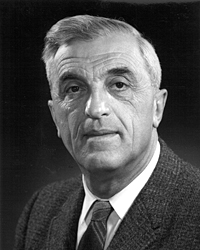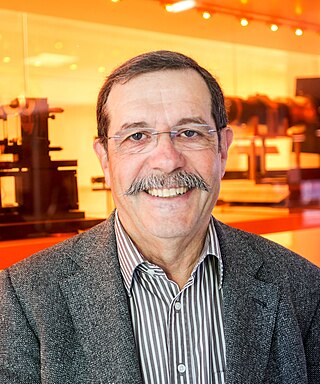Related Research Articles

Aage Niels Bohr was a Danish nuclear physicist who shared the Nobel Prize in Physics in 1975 with Ben Roy Mottelson and James Rainwater "for the discovery of the connection between collective motion and particle motion in atomic nuclei and the development of the theory of the structure of the atomic nucleus based on this connection". His father was Niels Bohr.
The Copenhagen interpretation is a collection of views about the meaning of quantum mechanics, stemming from the work of Niels Bohr, Werner Heisenberg, Max Born, and others. The term "Copenhagen interpretation" was apparently coined by Heisenberg during the 1950s to refer to ideas developed in the 1925–1927 period, glossing over his disagreements with Bohr. Consequently, there is no definitive historical statement of what the interpretation entails. Features common across versions of the Copenhagen interpretation include the idea that quantum mechanics is intrinsically indeterministic, with probabilities calculated using the Born rule, and the principle of complementarity, which states that objects have certain pairs of complementary properties that cannot all be observed or measured simultaneously. Moreover, the act of "observing" or "measuring" an object is irreversible, and no truth can be attributed to an object except according to the results of its measurement. Copenhagen-type interpretations hold that quantum descriptions are objective, in that they are independent of physicists' personal beliefs and other arbitrary mental factors.

Felix Bloch was a Swiss-American physicist and Nobel physics laureate who worked mainly in the U.S. He and Edward Mills Purcell were awarded the 1952 Nobel Prize for Physics for "their development of new ways and methods for nuclear magnetic precision measurements." In 1954–1955, he served for one year as the first director-general of CERN. Felix Bloch made fundamental theoretical contributions to the understanding of ferromagnetism and electron behavior in crystal lattices. He is also considered one of the developers of nuclear magnetic resonance.

Niels Henrik David Bohr was a Danish physicist who made foundational contributions to understanding atomic structure and quantum theory, for which he received the Nobel Prize in Physics in 1922. Bohr was also a philosopher and a promoter of scientific research.

Paul Adrien Maurice Dirac was an English theoretical physicist who is considered to be one of the founders of quantum mechanics and quantum electrodynamics. He was the Lucasian Professor of Mathematics at the University of Cambridge, a professor of physics at Florida State University and the University of Miami, and a 1933 Nobel Prize in Physics recipient.


James Franck was a German physicist who won the 1925 Nobel Prize for Physics with Gustav Hertz "for their discovery of the laws governing the impact of an electron upon an atom". He completed his doctorate in 1906 and his habilitation in 1911 at the Frederick William University in Berlin, where he lectured and taught until 1918, having reached the position of professor extraordinarius. He served as a volunteer in the German Army during World War I. He was seriously injured in 1917 in a gas attack and was awarded the Iron Cross 1st Class.

John Hasbrouck Van Vleck was an American physicist and mathematician. He was co-awarded the Nobel Prize in Physics in 1977, for his contributions to the understanding of the behavior of electronic magnetism in solids.

VictorFrederick "Viki" Weisskopf was an Austrian-born American theoretical physicist. He did postdoctoral work with Werner Heisenberg, Erwin Schrödinger, Wolfgang Pauli, and Niels Bohr. During World War II he was Group Leader of the Theoretical Division of the Manhattan Project at Los Alamos, and he later campaigned against the proliferation of nuclear weapons.

Alain Aspect is a French physicist noted for his experimental work on quantum entanglement.
In physics, complementarity is a conceptual aspect of quantum mechanics that Niels Bohr regarded as an essential feature of the theory. The complementarity principle holds that objects have certain pairs of complementary properties which cannot all be observed or measured simultaneously, for examples, position and momentum or wave and particle properties. In modern terms, complementarity encompasses both the uncertainty principle and wave-particle duality.

Hendrik Brugt Gerhard Casimir was a Dutch physicist who made significant contributions to the field of quantum mechanics and quantum electrodynamics. He is best known for his work on the Casimir effect, which describes the attractive force between two uncharged plates in a vacuum due to quantum fluctuations of the electromagnetic field.
The Niels Bohr International Gold Medal is an international engineering award. It has been awarded since 1955 for "outstanding work by an engineer or physicist for the peaceful utilization of atomic energy". The medal is administered by the Danish Society of Engineers (Denmark) in collaboration with the Niels Bohr Institute and the Royal Danish Academy of Sciences. It was awarded 10 times between 1955 and 1982 and again in 2013. The first recipient was Niels Bohr himself who received the medal in connection with his 70th birthday.
The history of quantum mechanics is a fundamental part of the history of modern physics. The major chapters of this history begin with the emergence of quantum ideas to explain individual phenomena -- blackbody radiation, the photoelectric effect, solar emission spectra -- an era called the Old or Older quantum theories. The invention of wave mechanics by Schrodinger and expanded by many others triggers the "modern" era beginning around 1925. Dirac's relativistic quantum theory work lead him to explore quantum theories of radiation, culminating in quantum electrodynamics, the first quantum field theory. The history of quantum mechanics continues in the history of quantum field theory. The history of quantum chemistry, theoretical basis of chemical structure, reactivity, and bonding, interlaces with the events discussed in this article.

Herwig Franz Schopper is a Czech-born experimental physicist and was the director general of CERN from 1981 to 1988.

Rolf-Dieter Heuer is a German particle physicist. From 2009 to 2015 he was Director General of CERN and from 5 April 2016 to 9 April 2018 President of the German Physical Society. Since 2015 he has been Chair of the European Commission's Group of Chief Scientific Advisors, and since May 2017 he has been President of the SESAME Council.
Some interpretations of quantum mechanics posit a central role for an observer of a quantum phenomenon. The quantum mechanical observer is tied to the issue of observer effect, where a measurement necessarily requires interacting with the physical object being measured, affecting its properties through the interaction. The term "observable" has gained a technical meaning, denoting a Hermitian operator that represents a measurement.
The Bohr family is a Danish family of scientists, scholars and amateur sportsmen. The most famous members are Niels Bohr, physicist and winner of the Nobel Prize in Physics in 1922, Aage Bohr, son of Niels, also a physicist and in 1975 also received the Nobel Prize, Harald Bohr, mathematician and brother of Niels, etc.

The idea that matter consists of smaller particles and that there exists a limited number of sorts of primary, smallest particles in nature has existed in natural philosophy at least since the 6th century BC. Such ideas gained physical credibility beginning in the 19th century, but the concept of "elementary particle" underwent some changes in its meaning: notably, modern physics no longer deems elementary particles indestructible. Even elementary particles can decay or collide destructively; they can cease to exist and create (other) particles in result.
References
- ↑ "Niels Bohr (1885-1962)". UNESCO. Retrieved 3 December 2013.
- ↑ Cian O'Luanaigh (5 December 2013). "UNESCO awards Niels Bohr Gold Medal to CERN". CERN. Retrieved 5 December 2013.
- ↑ "An Open World". University of Copenhagen. Retrieved 2 December 2013.
- ↑ "Niels Bohr Conference: Free exchange of information can avert technological threats". University of Copenhagen. 24 October 2013. Retrieved 2 December 2013.
- ↑ "UNESCO's Niels Bohr Gold Medal awarded to prominent physicists". University of Copenhagen. Retrieved 11 December 2013.